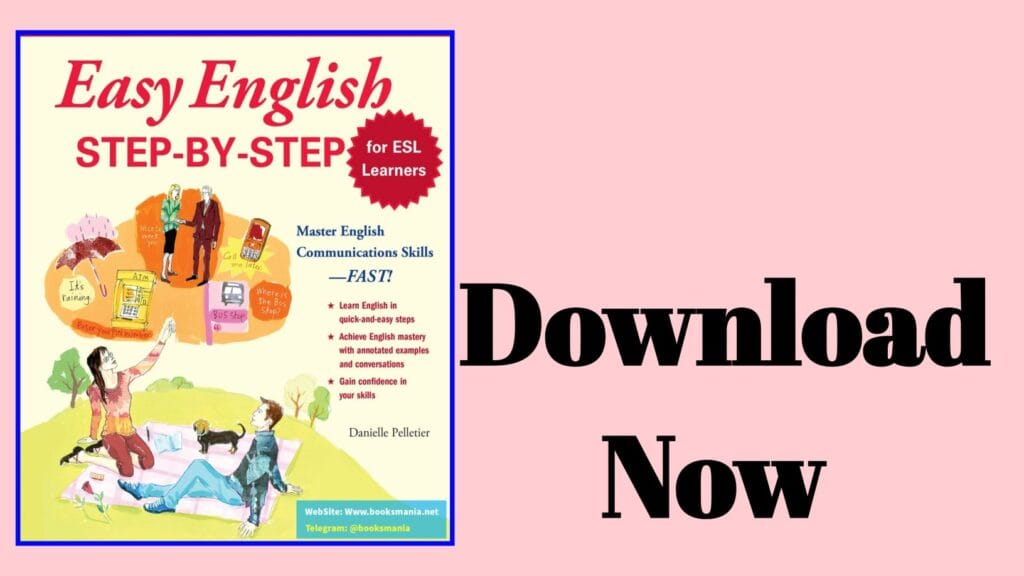
The Description of the Book
“Easy English Step by Step” is an English language teaching book whose main aim is to help the ESL learners master English communication skills through its amazingly written contents. The book is written keeping in mind the ESL (English as Second Language) learners’ perspectives in order to help them overcome the challenges they face while learning the English language.
The book features conversational topics that are encountered in everyday conversations, grammar lessons that are really important for the learners, dialogues between two or more people in particular situations such as at bus station, at restaurant or getting around town and tips and tricks to fasten improving communication skills in English.
Who Can Use This Book?
The title of the book makes it clear who this book was written for; that is, the book was written for the ESL learners, the learners who are learning English as a second language, not as a foreign language. The ESL learners of any level, be it basic, intermediate or advanced, can use this book to improve their English communication skills.
If you’re an ESL learner, no matter whether you’re at the basic, intermediate or advanced level, then you can certainly go with this book. Make sure that you dedicate enough time to reading it which will ensure your progress in improving English communication skills.
Note that if you’ve just started learning English grammar, and as you’re an ESL learner, then make sure that you can understand the book as it’s been written in English. If you can read and understand any grammar book in English, then only you can download the book and save it to your system and visit it on a regular basis.
Why Learn from This Book?
When it comes to choosing a book for improving English communication skills, you will want to make sure to look for certain features of the book you’re choosing to read. The book should be the best fit for you, the book should be written in an understandable way and the book should be authentic.
Here’s why you prefer this book:
- Full Communication Package: Communication skills go beyond using a language. It includes focusing on your body language, gesture, manners and all that. This book gives a full package for improving your English communication skills which includes all the things in one place.
- Conversational Topics: In this book, the author has made sure to include the most common situational conversational topics that you need to learn as a second language learner. It focuses on grammar and vocabulary skills which ensure that you be understood by the others.
- Tips and Tricks: One of the most important features of the book is that it gives tips and tricks on how to improve English communication skills easily. You will find them in each and every section or lesson of the book which ensures that you learn and apply them correctly.
The Table of Content
Introduction
1 Meeting People
Greeting People
Formal and Informal Greetings
Conversation: Greeting People
Saying Good-Bye
Meeting People
The Six Steps to Meeting Someone
Conversation: Meeting People
Grammar: Subject Pronouns
Grammar: BE Verb
Grammar: Adjectives
Talking About the Weather
Using the Negative
Using Intensifier Adverbs
Vocabulary: Phrasal Verbs
Reading About It
Step 1: Pre-Read
Step 2: Read Actively
Step 3: Understand What You Read
Let’s Read Together
Writing About It
How to Begin a Sentence
How to End a Sentence
Do It Out There!
Weekly Log
2 Habits, Customs, and Routines
Talking About Habits, Customs, and Routines
Talking About Family
Grammar: Using the Simple Present Verb Tense
Grammar: Using Adverbs of Frequency
Grammar: Asking WH Questions in the Simple Present Tense
Grammar: Yes/No Questions with Non-BE Verbs in the Simple Present Tense
Vocabulary: Phrasal Verbs for Daily Activities
Introducing Someone
Conversation: Introducing Someone to Someone Else
Reading About It
Let’s Read Together
Topics and Main Ideas
Reading Actively
Writing About It
Subject-Verb Agreement with the Simple Present Verb Tense
Proper Nouns
Do It Out There!
Weekly Log
3 Food: Shopping and Restaurants
Talking About What People Are Doing Now
Grammar: Using the Present Progressive Verb Tense
Grammar: Asking WH Questions in the Present Progressive Tense
Grammar: Count and Noncount Nouns
Grammar: Definite and Indefinite Articles
Eating at a Restaurant
Vocabulary: Phrasal Verbs for Eating, Food, and Restaurants
Conversation: Making Polite Requests at a Restaurant
Reading About It
Topics and Main Ideas
Discovering Meaning Through Context
Writing About It
Using Commas in a List
Do It Out There!
Weekly Log
4 Getting Around Town
Walking Around Town: Giving and Getting Directions
Conversation: Asking for Directions
Vocabulary: City Center
Grammar: Using the Imperative
Vocabulary: Expressions Used in Directions
Vocabulary: Prepositions of Place
Grammar: There Is/There Are
Describing Your Town
Communication Strategy: Understanding Directions
Taking Public Transportation
Conversation: Public Transportation Schedules
Grammar: The Simple Present Verb Tense for Schedules
Vocabulary: Public Transportation
Vocabulary: Expressions of Time
Vocabulary: Phrasal Verbs for Getting Around Town
Reading About It
Let’s Read Together
Discovering Meaning Through Context
Writing About It
Identifying the SVO Sentence Structure
Do It Out There!
Weekly Log
5 Recreation and Hobbies
Talking About Last Weekend
Conversation: Talking About What You Did
Grammar: Using the Simple Past Verb Tense
Time Expressions for the Past Tense
Vocabulary: Recreation and Hobbies
Grammar: Asking Questions with the Simple Past Verb Tense
Grammar: The Simple Past BE Verb
Expressing Attitudes for Recreation and Hobbies
Grammar: Gerunds and Infinitives
Grammar: Possessive Adjectives
Communication Strategy: Encouraging Someone
Communication Strategy: Expressing Disbelief
Conversation: Talking About the Weekend
Vocabulary: Phrasal Verbs for Recreation and Hobbies
Reading About It
Discovering Meaning Through Context: Contrast
Let’s Read Together
Writing About It
Interjections: Using the Exclamation Point and Question Mark
Writing About Past Actions
Do It Out There!
Weekly Log
6 Making Friends
Talking to New Friends
Conversation: Making a New Friend
Communication Strategy: Small Talk
How to Make Friends
Grammar: Possessive Pronouns
Grammar: Demonstrative Adjectives
Grammar: Demonstrative Pronouns
Spending Time with Friends
Communication Strategy: Making Invitations
Communication Strategy: Accepting Invitations
Communication Strategy: Declining Invitations
Communication Strategy: Suggesting Activities
Communication Strategy: Sharing Contact Information
Vocabulary: Phrasal Verbs for Plans and Activities
Conversation: Putting It All Together
Reading About It
Let’s Read Together
Writing About It
The SVC Sentence Structure
Identifying the SVC Sentence Structure
Do It Out There!
Weekly Log
7 Health and Medicine
Talking About Illness
Real Conversation: Describing Pain
Grammar: Using the Present Perfect Progressive Tense
Communication Strategy: Describing Symptoms
Vocabulary: Symptoms and Ailments
Consulting a Doctor
Communication Strategy: Giving Advice
Communication Strategy: Asking for Advice
Communication Strategy: Asking for Permission
Vocabulary: Phrasal Verbs for Health
Conversation: Putting It All Together
Reading About It
Let’s Read Together
Identifying Supporting Ideas in a Paragraph
Writing About It
Structure of a Paragraph
Do It Out There!
Weekly Log
8 Shopping and Clothing
Talking About Shopping
Conversation: At a Clothing Store
Grammar: Using the Future Verb Tense
Communication Strategy: Offering and Asking for Help
Vocabulary: Clothing
Vocabulary: Phrasal Verbs for Shopping
Prepositions of Time
Grammar: Object Pronouns
Talking About Clothes
Vocabulary: Adverbs and Adjectives
Vocabulary: Comparatives
Vocabulary: Superlatives
Communication Strategy: Asking for and Giving Opinions
Conversation: Putting It All Together
Reading About It
Let’s Read Together
Writing About It
Review: Structure of a Paragraph
Do It Out There!
Weekly Log
Appendix: Useful Resources for ESL Students
Answer Key
Index


